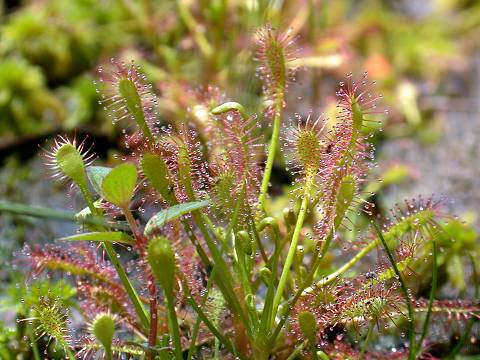

Drosera intermedia - (image 1 of 4)
Taxonomy
Family: Droseraceae
Habitat
Acid bogs and sandy shores.
Associates
Some of these specimens were found growing with Drosera rotundifolia, Eriocaulon compressum, Iris versicolor, Sarracenia purpurea, Sphagnum spp., Vaccinium macrocarpon, Viola lanceolata.
Distribution
Circumboreal; in North America from Newfoundland to FL, west to MN, IL, TN, and TX.
Morphology
Perennial. Leaves covered in glandular hairs that exude a sticky substance; blade of leaves spatulate, longer than broad, some of the leaves originating on nodes above the rosette. Flowers white on a scape to 80 cm; sepals 3-4 mm; petals 4-5 mm; stamens 5; ovary superior. Fruit a capsule; seeds papillose.
Notes
Flowers early July to mid September
Wetland indicator: Obligate
These little plants are very photogenic. The sticky hairs are used to trap insects. The plants are able then to use the nitrogen from the insects to compensate for low available nitrogen in their acidic habitats.
References
Gleason, Henry A.
and A. Cronquist. 1991. Manual of Vascular Plants of Northeastern United States
and Adjacent Canada. Second Ed.
The New York Botanical Garden. Bronx, NY
Niering, W. A. 1979. The Audubon society field guide to North American
wildflowers: eastern region.
Knopf/Random House, New York.
Swink, F. and G. Wilhelm. 1994. Plants of the Chicago Region.
Indiana Academy of Science. The Morton Arboretum. Lisle, Illinois.
|
Michael Hough © 2004 |